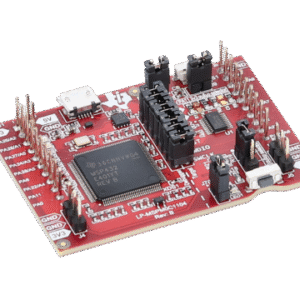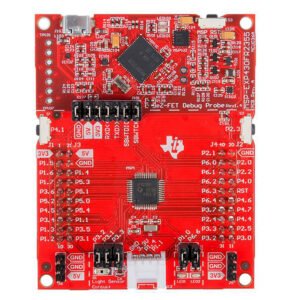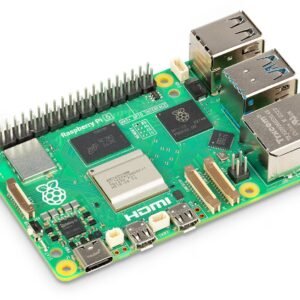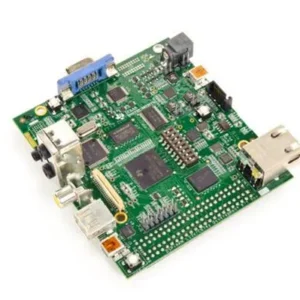101020616 Seeed Studio ACS725 – 10A DC Current Sensor High-Precision DC Measurement
- 10 A DC made easy – Drop-in Grove module with ≈264 mV/A scale; read with any ADC.
- Low loss, high fidelity – ~1.2 mΩ primary path and differential Hall architecture for low error and minimal heating.
- Tune your noise – 120 kHz default bandwidth; add a capacitor on FILTER to boost resolution when needed.
In Stock
Request a QuoteSeeed Studio ACS725 Grove Current Sensor Overview, Specifications & Applications
The Grove – 10A DC Current Sensor (ACS725), SKU 101020616, is a plug-and-play module designed to give makers, engineers, and educators a fast, accurate, and low-noise way to measure direct current up to 10 A. Built around Allegro’s ACS725 Hall-effect current-sensor IC, this Grove board converts the current flowing through its primary conduction path into a precise, ratiometric analog voltage that your controller can read on any standard ADC pin.
Compared with older Hall sensor boards such as those based on ACS712, the ACS725 architecture delivers higher sensitivity and better linearity, which translates into greater resolution at low currents and more predictable readings over temperature. The end result is a compact, cost-effective current-sensing solution for DC motor control, battery fuel-gauging, DC power monitoring, and over-current protection in hobbyist and professional designs alike.
Important note: this Grove module is intended for DC current measurement only (0 → 10 A). Although the underlying ACS725 IC is capable of AC or DC sensing, Seeed’s Grove configuration here is focused on DC use to keep integration simple and consistent with typical battery- and motor-powered projects.
Under the hood, the ACS725 integrates a low-offset linear Hall sensor and a 1.2 mΩ copper primary conductor in a compact SOIC-8 package. Current through the conductor generates a magnetic field which the Hall plate senses and converts into a voltage proportional to the current. Because the device uses differential Hall sensing, it rejects external common-mode magnetic fields (from motors, relays, or nearby traces), improving robustness in electrically noisy environments. The IC offers a high-bandwidth 120 kHz analog output, a user-accessible FILTER pin to trade bandwidth for lower noise, and industry-leading noise performance thanks to its internal amplifier and filtering topology.
For a 10 A full-scale DC range, the Seeed Grove module leverages the ACS725 10 A, 264 mV/A sensitivity variant. With a typical 3.3 V supply, that means 2.64 V of span from zero current to 10 A (unidirectional configuration), making it easy to resolve fine changes with common 10- or 12-bit ADCs. The ratiometric output simplifies calibration because any supply variation scales the output proportionally.
Grove’s standardized 4-pin connector and keyed cable remove the headache of jumpers and soldering. Connect the module to a Grove Base Shield (or any Grove-compatible controller) and start reading current within minutes. Whether you’re instrumenting a robotics drivetrain, logging solar-panel charge current, or implementing current-based fault detection in a DC power rail, this sensor gives you clean, fast data with minimal code and hardware effort.
Specifications
Below is a consolidated specification table for the Seeed Studio Grove – 10A DC Current Sensor (ACS725). Values specific to the ACS725 IC are indicated and, where applicable, reflect the typical performance of the 10 A variant at 3.3 V.
| Parameter | Value |
|---|---|
| Product name | Grove – 10A DC Current Sensor (ACS725) |
| SKU | 101020616 |
| Sensing principle | Linear Hall-effect, differential sensing (ACS725 IC) |
| Measurement type | DC current (module focus); IC supports AC/DC sensing |
| Current range | 0 → 10 A DC (unidirectional module configuration) |
| Sensitivity | ~264 mV/A at VCC = 3.3 V (ACS725 10 A option) |
| Output type | Analog voltage, ratiometric to supply (VIOUT) |
| Output bandwidth | 120 kHz (–3 dB, small signal); user-configurable via FILTER pin on IC |
Applications & integration tips
1) Battery and energy projects
Whether you’re profiling lithium packs or building a UPS, the Grove ACS725 lets you continuously log charge/discharge current to estimate state-of-charge and detect faults. Use the filter pin to add a small capacitor (e.g., 1–4.7 nF) if you prefer smoother, lower-noise readings over raw bandwidth. For extremely low-current resolution, average multiple ADC samples in firmware.
2) Robotics and mechatronics
DC motors can draw several times their rated current during startup or stall. Thanks to the IC’s low primary resistance and inrush robustness, this sensor allows you to watch for spikes without causing a big voltage drop in the motor line. Tie the analog output into your controller’s ADC and trigger a cutoff or slowdown when current crosses a limit.
3) Power electronics instrumentation
In converters, drivers, and LED supplies, it’s often necessary to observe current waveforms or track load changes. With the ACS725’s ~120 kHz bandwidth, you can capture transient behavior at control-loop rates, while the FILTER pin gives you an easy pathway to quiet the output for steady-state trending.
4) Lab rail monitoring
Drop the sensor inline with a lab rail and stream the analog output into a data logger or MCU. Because VIOUT is ratiometric, using the same reference as your ADC improves absolute accuracy across supply variation.
Wiring & reading the sensor
-
Insert the sensor into the DC path: Route the positive side of your load through the Grove board’s “IP+ → IP–” terminals so that current flows in the correct direction relative to the sensor’s sensitivity slope (the ACS725 output rises with increasing positive current through IP+ to IP–).
-
Connect the Grove cable to an analog port on your base board. Power and ground are provided via the Grove connector; the analog line carries VIOUT.
-
Interpret the output: At 0 A, a unidirectional ACS725 variant targets ≈0.1 × VCC. Each amp adds ≈264 mV. For example, if VCC = 3.3 V, 0 A ≈ 0.33 V and 5 A ≈ 0.33 + (0.264 × 5) ≈ 1.65 V. (Use your board’s exact VCC and calibration.)
-
Optionally add a FILTER capacitor between FILTER and ground to reduce bandwidth and noise; values in the 1–4.7 nF range are common starting points (select based on your noise vs. response needs).
Tip: Because the ACS725 is ratiometric, referencing your ADC to the same supply that powers the sensor will naturally cancel some supply drift.
Accuracy notes
Like all Hall-based current sensors, accuracy depends on sensitivity error and offset. The ACS725 datasheet provides guidance and typical distributions; at higher currents, the error is dominated by sensitivity, and at very low currents, offset becomes the larger contributor (as a percentage). If you need tighter system accuracy, consider a one-point or two-point calibration in your firmware to record your unit’s 0 A output and gain factor with a known load. The device features nearly zero magnetic hysteresis and chopper-stabilized circuitry for a stable quiescent output over time and temperature.
Safety & handling
-
The Seeed Studio ACS725 IC provides galvanic isolation between the primary current path and the signal pins; even so, follow safe wiring practices, maintain spacing, and mount the module to avoid accidental contact with energized conductors. IC package data indicates ~2400 Vrms dielectric strength and ~4.2 mm creepage/clearance—use this as engineering data, but design your enclosure and PCB spacing to your standards and codes.
-
Observe thermal limits: while the IC is specified up to high ambient temperatures, always ensure the Grove board and surrounding wiring remain within safe operating temperatures for your application.
Specification: Seeed Studio ACS725 – 10A DC Current Sensor High-Precision DC Measurement
|
User Reviews
Only logged in customers who have purchased this product may leave a review.








There are no reviews yet.